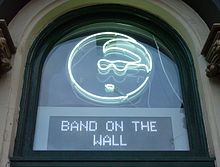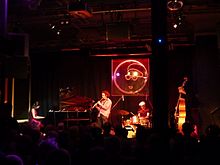Beswick Prize Bands Big Drum
Well-Known Member
Has the pub Band on the wall always been on Swan street, was it ever down Tib street in the 60s.
My youngest daughter worked there (Swan Street) for about 12 months,finishing in 2018.Weekends she usually didn`t get home until 5.00 am.Has the pub Band on the wall always been on Swan street, was it ever down Tib street in the 60s.


That's why I'm asking.60's?? If you remember them you weren't there!!
Thanks for that.Early history[edit]
The building dates back to around 1862 when a local brewery, the McKenna Brothers, built it as the flagship pub of their operation. It was called the George and Dragon; the first licence on the site was granted to Elizabeth March in 1803. No-one knows when music started to be played at the venue but market pubs were well known for their musical connections, and the nearby Smithfield Markets[1] and textile factories ensured that this was a bustling area with many musicians and buskers. Manchester was then at its height as the first industrial city at the forefront of the Industrial Revolution.
The 'Band on the Wall' was a nickname from the 1930s when the landlord of the time Ernie Tyson placed a stage high on the far wall of the pub on which the musicians played. A regular band of two accordions, piano, drums, a singer and occasionally a saxophone would play.
During World War II the venue was popular with British, American, Canadian and French servicemen as well as the local market traders and mill workers. Italian prisoners of war and deserters were rumoured to frequent the establishment. The band often played on during air raids, particularly as they became more common. Walter Greenwood wrote that a record 24,000 bottles of beer were sold here on one day of a Bank Holiday weekend.[2]
Later history[edit]
The Band on the Wall's iconic logo
The Zoe Rahman Quartet playing at Band on the Wall during the Manchester Jazz festival in 2012
The area fell into decline during the middle of the 20th century as the textile manufacturing industry declined and many people left the area; the market was also suffering.
In 1975 local jazz musician Steve Morris and his business partner Frank Cusick bought the George & Dragon with the idea of turning it into a jazz club; a conversation with Johnny Roadhouse convinced them to name it the Band on the Wall. Jazz musicians from the local area as well as international artist played at the club. The late 1970s saw the emergence of a new sound, punk, and it was at the Band on the Wall that many of the Manchester punk bands played. This was part of the New Manchester Review nights, a fanzine and listings magazine which was the starting point for the now defunct City Life. Many notable post-punk bands played during this time including Buzzcocks and the Fall amongst others. The venue was also used by the Manchester Musicians Collective. An album entitled A Manchester Collection was released by Object Records featuring some of those members in April 1979. Several other bands later released music through Factory Records, including Joy Division and A Certain Ratio. In 1982 the venue briefly closed for some internal redevelopment work. It was after the reopening that the Dizzy Gillespie logo was first used. It was during this decade that the venue began to gain an international reputation for so-called "World Music" and a programme that covered multiple genres. Performers who went on to gain international reputations included Mick Hucknall, who played on several occasions as Frantic Elevators. Other notable performances came from Purrkur Pillnikk, who supported The Fall for three dates in 1982, with supporting vocals from a young Björk.[3]
Rebirth[edit]
Band on the Wall is operated by Inner City Music Ltd, a registered charity. The organisation was awarded £3.2 million in July 2007, in combined awards by Arts Council England and the Heritage Lottery Fund as part of a £4 million project to transform the venue into a 21st-century centre for music.
The Band on the Wall was refurbished before reopening on September 25, 2009 with a performance by the venue's patrons Julian Joseph and Mica Paris.[4][5]
On 18th June 2018, Inner City Music Ltd announced that Arts Council England had approved £1.65 million stage two Capital funding for the venue’s Bigger, Better, Stronger expansion plan.[6][7] The plans include the renovation of the derelict Cocozza building, which adjoins the venue.
Fascinating that, didn't realise had such a long history.Early history[edit]
The building dates back to around 1862 when a local brewery, the McKenna Brothers, built it as the flagship pub of their operation. It was called the George and Dragon; the first licence on the site was granted to Elizabeth March in 1803. No-one knows when music started to be played at the venue but market pubs were well known for their musical connections, and the nearby Smithfield Markets[1] and textile factories ensured that this was a bustling area with many musicians and buskers. Manchester was then at its height as the first industrial city at the forefront of the Industrial Revolution.
The 'Band on the Wall' was a nickname from the 1930s when the landlord of the time Ernie Tyson placed a stage high on the far wall of the pub on which the musicians played. A regular band of two accordions, piano, drums, a singer and occasionally a saxophone would play.
During World War II the venue was popular with British, American, Canadian and French servicemen as well as the local market traders and mill workers. Italian prisoners of war and deserters were rumoured to frequent the establishment. The band often played on during air raids, particularly as they became more common. Walter Greenwood wrote that a record 24,000 bottles of beer were sold here on one day of a Bank Holiday weekend.[2]
Later history[edit]
The Band on the Wall's iconic logo
The Zoe Rahman Quartet playing at Band on the Wall during the Manchester Jazz festival in 2012
The area fell into decline during the middle of the 20th century as the textile manufacturing industry declined and many people left the area; the market was also suffering.
In 1975 local jazz musician Steve Morris and his business partner Frank Cusick bought the George & Dragon with the idea of turning it into a jazz club; a conversation with Johnny Roadhouse convinced them to name it the Band on the Wall. Jazz musicians from the local area as well as international artist played at the club. The late 1970s saw the emergence of a new sound, punk, and it was at the Band on the Wall that many of the Manchester punk bands played. This was part of the New Manchester Review nights, a fanzine and listings magazine which was the starting point for the now defunct City Life. Many notable post-punk bands played during this time including Buzzcocks and the Fall amongst others. The venue was also used by the Manchester Musicians Collective. An album entitled A Manchester Collection was released by Object Records featuring some of those members in April 1979. Several other bands later released music through Factory Records, including Joy Division and A Certain Ratio. In 1982 the venue briefly closed for some internal redevelopment work. It was after the reopening that the Dizzy Gillespie logo was first used. It was during this decade that the venue began to gain an international reputation for so-called "World Music" and a programme that covered multiple genres. Performers who went on to gain international reputations included Mick Hucknall, who played on several occasions as Frantic Elevators. Other notable performances came from Purrkur Pillnikk, who supported The Fall for three dates in 1982, with supporting vocals from a young Björk.[3]
Rebirth[edit]
Band on the Wall is operated by Inner City Music Ltd, a registered charity. The organisation was awarded £3.2 million in July 2007, in combined awards by Arts Council England and the Heritage Lottery Fund as part of a £4 million project to transform the venue into a 21st-century centre for music.
The Band on the Wall was refurbished before reopening on September 25, 2009 with a performance by the venue's patrons Julian Joseph and Mica Paris.[4][5]
On 18th June 2018, Inner City Music Ltd announced that Arts Council England had approved £1.65 million stage two Capital funding for the venue’s Bigger, Better, Stronger expansion plan.[6][7] The plans include the renovation of the derelict Cocozza building, which adjoins the venue.
Nor me.There is more about it on Google,I just put a few lines on.Fascinating that, didn't realise had such a long history.
